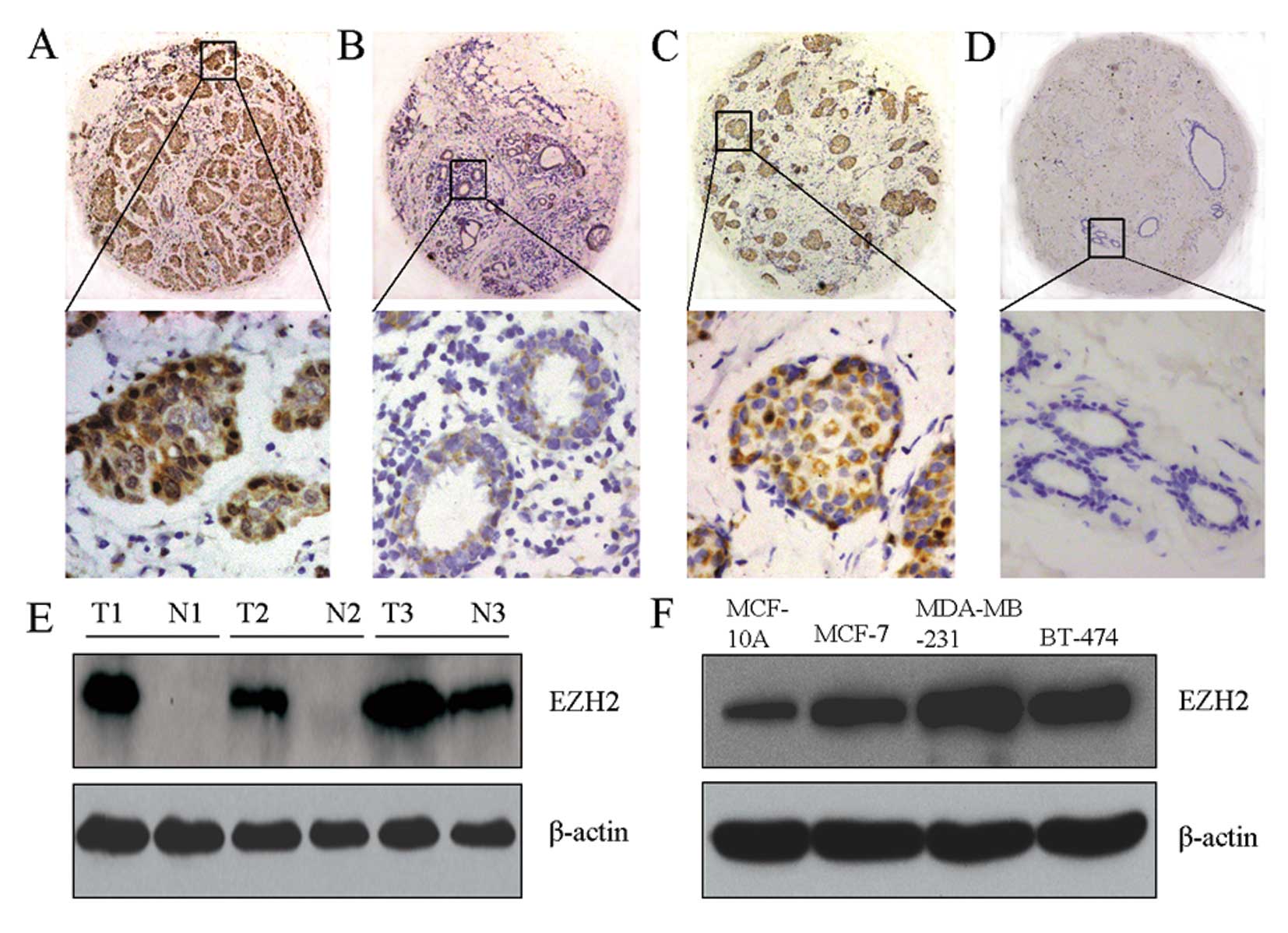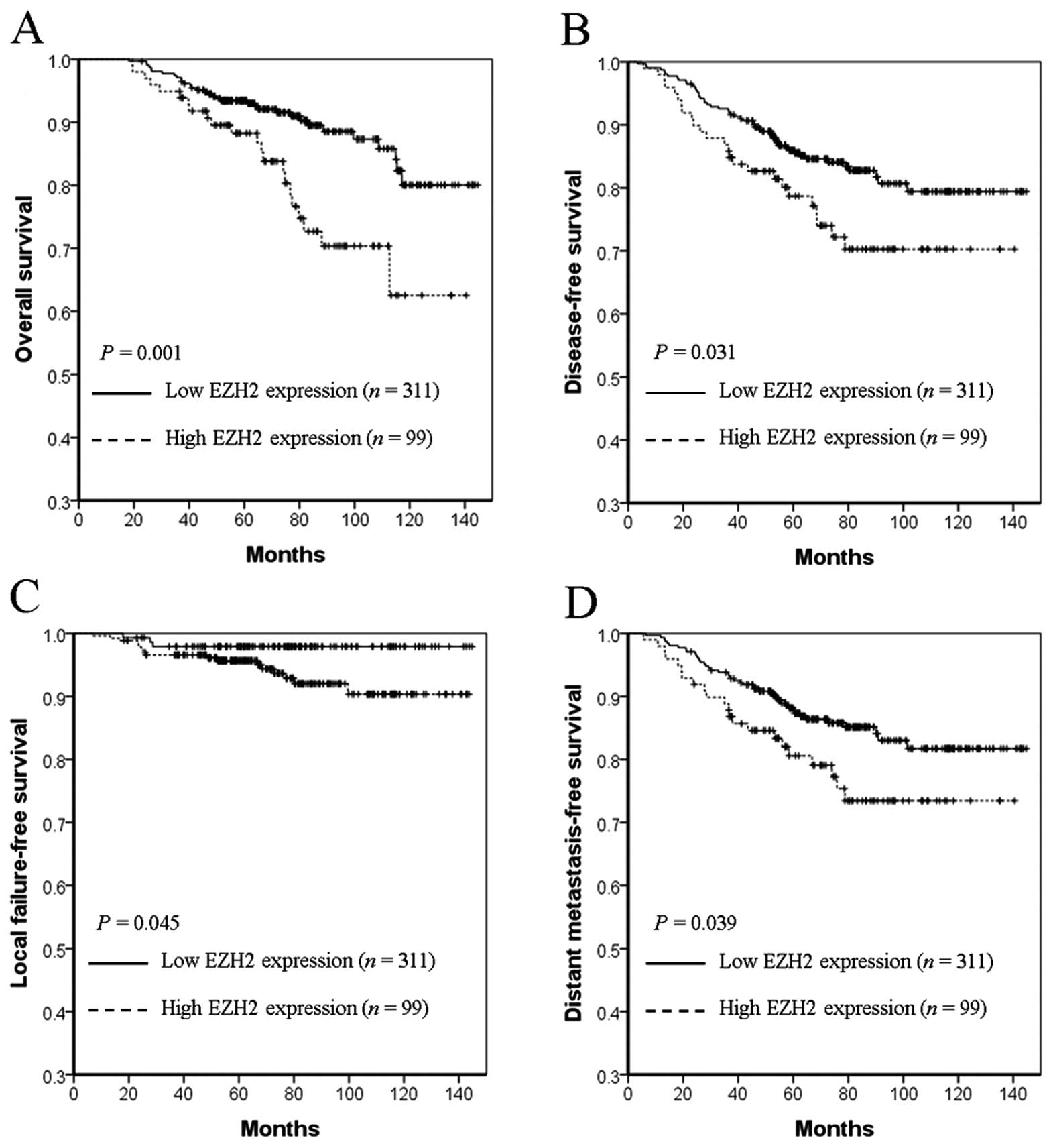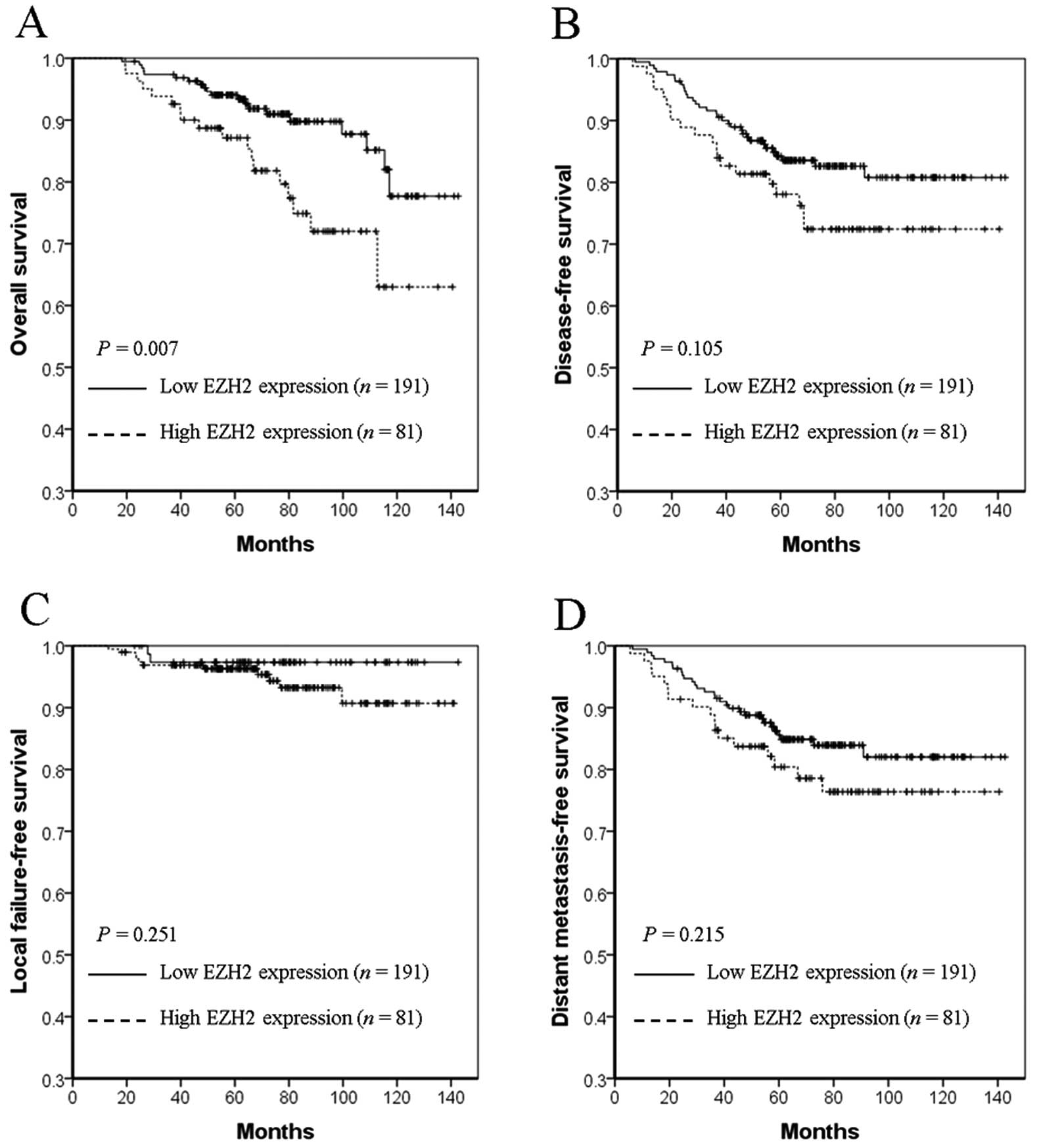|
1
|
Fujii S, Ito K, Ito Y and Ochiai A:
Enhancer of zeste homologue 2 (EZH2) down-regulates RUNX3 by
increasing histone H3 methylation. J Biol Chem. 283:17324–17332.
2008. View Article : Google Scholar : PubMed/NCBI
|
|
2
|
Du J, Li L, Ou Z, et al: FOXC1, a target
of polycomb, inhibits metastasis of breast cancer cells. Breast
Cancer Res Treat. 131:65–73. 2012. View Article : Google Scholar : PubMed/NCBI
|
|
3
|
Cao Q, Yu J, Dhanasekaran SM, et al:
Repression of E-cadherin by the polycomb group protein EZH2 in
cancer. Oncogene. 27:7274–7284. 2008. View Article : Google Scholar : PubMed/NCBI
|
|
4
|
Bachmann IM, Halvorsen OJ, Collett K, et
al: EZH2 expression is associated with high proliferation rate and
aggressive tumor subgroups in cutaneous melanoma and cancers of the
endometrium, prostate, and breast. J Clin Oncol. 24:268–273. 2006.
View Article : Google Scholar : PubMed/NCBI
|
|
5
|
Richter GH, Plehm S, Fasan A, et al: EZH2
is a mediator of EWS/FLI1 driven tumor growth and metastasis
blocking endothelial and neuro-ectodermal differentiation. Proc
Natl Acad Sci USA. 106:5324–5329. 2009. View Article : Google Scholar : PubMed/NCBI
|
|
6
|
Au SL, Wong CC, Lee JM, et al: Enhancer of
zeste homolog 2 epigenetically silences multiple tumor suppressor
microRNAs to promote liver cancer metastasis. Hepatology.
56:622–631. 2012. View Article : Google Scholar : PubMed/NCBI
|
|
7
|
Ren G, Baritaki S, Marathe H, et al:
Polycomb protein EZH2 regulates tumor invasion via the
transcriptional repression of the metastasis suppressor RKIP in
breast and prostate cancer. Cancer Res. 72:3091–3104. 2012.
View Article : Google Scholar : PubMed/NCBI
|
|
8
|
Granit RZ, Gabai Y, Hadar T, et al: EZH2
promotes a bi-lineage identity in basal-like breast cancer cells.
Oncogene. 32:3886–3895. 2013. View Article : Google Scholar : PubMed/NCBI
|
|
9
|
Kleer CG, Cao Q, Varambally S, et al: EZH2
is a marker of aggressive breast cancer and promotes neoplastic
transformation of breast epithelial cells. Proc Natl Acad Sci USA.
100:11606–11611. 2003. View Article : Google Scholar : PubMed/NCBI
|
|
10
|
Mimori K, Ogawa K, Okamoto M, Sudo T,
Inoue H and Mori M: Clinical significance of enhancer of zeste
homolog 2 expression in colorectal cancer cases. Eur J Surg Oncol.
31:376–380. 2005. View Article : Google Scholar : PubMed/NCBI
|
|
11
|
Yonemitsu Y, Imazeki F, Chiba T, et al:
Distinct expression of polycomb group proteins EZH2 and BMI1 in
hepatocellular carcinoma. Hum Pathol. 40:1304–1311. 2009.
View Article : Google Scholar : PubMed/NCBI
|
|
12
|
Rao ZY, Cai MY, Yang GF, et al: EZH2
supports ovarian carcinoma cell invasion and/or metastasis via
regulation of TGF-beta1 and is a predictor of outcome in ovarian
carcinoma patients. Carcinogenesis. 31:1576–1583. 2010. View Article : Google Scholar : PubMed/NCBI
|
|
13
|
Cao W, Feng Z, Cui Z, et al: Up-regulation
of enhancer of zeste homolog 2 is associated positively with cyclin
D1 overexpression and poor clinical outcome in head and neck
squamous cell carcinoma. Cancer. 118:2858–2871. 2012. View Article : Google Scholar : PubMed/NCBI
|
|
14
|
Lee H, Yoon SO, Jeong WY, Kim HK, Kim A
and Kim BH: Immunohistochemical analysis of polycomb group protein
expression in advanced gastric cancer. Hum Pathol. 43:1704–1710.
2012. View Article : Google Scholar : PubMed/NCBI
|
|
15
|
Huqun, Ishikawa R, Zhang J, et al:
Enhancer of zeste homolog 2 is a novel prognostic biomarker in
nonsmall cell lung cancer. Cancer. 118:1599–1606. 2012. View Article : Google Scholar : PubMed/NCBI
|
|
16
|
Collett K, Eide GE, Arnes J, et al:
Expression of enhancer of zeste homologue 2 is significantly
associated with increased tumor cell proliferation and is a marker
of aggressive breast cancer. Clin Cancer Res. 12:1168–1174. 2006.
View Article : Google Scholar : PubMed/NCBI
|
|
17
|
Athanassiadou AM, Tsipis A, Patsouris E,
et al: Enhancer of zeste homologue 2 expression in breast carcinoma
smears in relationship with p53, Ki-67 and other prognostic
parameters. Acta Cytol. 55:180–186. 2011. View Article : Google Scholar : PubMed/NCBI
|
|
18
|
Alford SH, Toy K, Merajver SD and Kleer
CG: Increased risk for distant metastasis in patients with familial
early-stage breast cancer and high EZH2 expression. Breast Cancer
Res Treat. 132:429–437. 2012. View Article : Google Scholar : PubMed/NCBI
|
|
19
|
Semenza GL: Regulation of mammalian
O2 homeostasis by hypoxia-inducible factor 1. Annu Rev
Cell Dev Biol. 15:551–578. 1999.
|
|
20
|
Schito L, Rey S, Tafani M, et al:
Hypoxia-inducible factor 1-dependent expression of platelet-derived
growth factor B promotes lymphatic metastasis of hypoxic breast
cancer cells. Proc Natl Acad Sci USA. 109:E2707–E2716. 2012.
View Article : Google Scholar : PubMed/NCBI
|
|
21
|
Schindl M, Schoppmann SF, Samonigg H, et
al: Overexpression of hypoxia-inducible factor 1alpha is associated
with an unfavorable prognosis in lymph node-positive breast cancer.
Clin Cancer Res. 8:1831–1837. 2002.PubMed/NCBI
|
|
22
|
Wan XB, Fan XJ, Chen MY, et al: Elevated
Beclin 1 expression is correlated with HIF-1alpha in predicting
poor prognosis of nasopharyngeal carcinoma. Autophagy. 6:395–404.
2010. View Article : Google Scholar : PubMed/NCBI
|
|
23
|
Dong M, Wan XB, Yuan ZY, et al: Low
expression of Beclin 1 and elevated expression of HIF-1α refine
distant metastasis risk and predict poor prognosis of ER-positive,
HER2-negative breast cancer. Med Oncol. 30:3552013.PubMed/NCBI
|
|
24
|
Cao P, Deng Z, Wan M, et al: MicroRNA-101
negatively regulates Ezh2 and its expression is modulated by
androgen receptor and HIF-1alpha/HIF-1beta. Mol Cancer. 9:1082010.
View Article : Google Scholar : PubMed/NCBI
|
|
25
|
Wan XB, Fan XJ, Huang PY, et al: Aurora-A
activation, correlated with hypoxia-inducible factor-1α, promotes
radiochemoresistance and predicts poor outcome for nasopharyngeal
carcinoma. Cancer Sci. 103:1586–1594. 2012.
|
|
26
|
Park JH, Lee JY, Shin DH, Jang KS, Kim HJ
and Kong G: Loss of Mel-18 induces tumor angiogenesis through
enhancing the activity and expression of HIF-1alpha mediated by the
PTEN/PI3K/Akt pathway. Oncogene. 30:4578–4589. 2011. View Article : Google Scholar : PubMed/NCBI
|
|
27
|
Chang CJ, Yang JY, Xia W, et al: EZH2
promotes expansion of breast tumor initiating cells through
activation of RAF1-β-catenin signaling. Cancer Cell. 19:86–100.
2011.PubMed/NCBI
|
|
28
|
Elston CW and Ellis IO: Pathological
prognostic factors in breast cancer. I The value of histological
grade in breast cancer: experience from a large study with
long-term follow-up. Histopathology. 19:403–410. 1991. View Article : Google Scholar
|
|
29
|
Fan XJ, Wan XB, Yang ZL, et al: Snail
promotes lymph node metastasis and Twist enhances tumor deposit
formation through epithelial-mesenchymal transition in colorectal
cancer. Hum Pathol. 44:173–180. 2013. View Article : Google Scholar
|
|
30
|
Wan XB, Zhao Y, Fan XJ, et al: Molecular
prognostic prediction for locally advanced nasopharyngeal carcinoma
by support vector machine integrated approach. PLoS One.
7:e319892012. View Article : Google Scholar : PubMed/NCBI
|
|
31
|
Sauvageau M and Sauvageau G: Polycomb
group proteins: multi-faceted regulators of somatic stem cells and
cancer. Cell Stem Cell. 7:299–313. 2010. View Article : Google Scholar : PubMed/NCBI
|
|
32
|
Gong Y, Huo L, Liu P, et al: Polycomb
group protein EZH2 is frequently expressed in inflammatory breast
cancer and is predictive of worse clinical outcome. Cancer.
117:5476–5484. 2011. View Article : Google Scholar : PubMed/NCBI
|
|
33
|
De Brot M, Rocha RM, Soares FA and Gobbi
H: Prognostic impact of the cancer stem cell related markers ALDH1
and EZH2 in triple negative and basal-like breast cancers.
Pathology. 44:303–312. 2012.PubMed/NCBI
|
|
34
|
Pietersen AM, Horlings HM, Hauptmann M, et
al: EZH2 and BMI1 inversely correlate with prognosis and TP53
mutation in breast cancer. Breast Cancer Res. 10:R1092008.
View Article : Google Scholar : PubMed/NCBI
|
|
35
|
Jansen MP, Reijm EA, Sieuwerts AM, et al:
High miR-26a and low CDC2 levels associate with decreased EZH2
expression and with favorable outcome on tamoxifen in metastatic
breast cancer. Breast Cancer Res Treat. 133:937–947. 2012.
View Article : Google Scholar : PubMed/NCBI
|
|
36
|
Lee ST, Li Z, Wu Z, et al:
Context-specific regulation of NF-κB target gene expression by EZH2
in breast cancers. Mol Cell. 43:798–810. 2011.
|
|
37
|
Shapochka DO, Zaletok SP and Gnidyuk MI:
Relationship between NF-κB, ER, PR, Her2/neu, Ki67, p53 expression
in human breast cancer. Exp Oncol. 34:358–363. 2012.
|
|
38
|
Wang Y, Yin Q, Yu Q, et al: A
retrospective study of breast cancer subtypes: the risk of relapse
and the relations with treatments. Breast Cancer Res Treat.
130:489–498. 2011. View Article : Google Scholar : PubMed/NCBI
|
|
39
|
Gatza ML, Kung HN, Blackwell KL, Dewhirst
MW, Marks JR and Chi JT: Analysis of tumor environmental response
and oncogenic pathway activation identifies distinct basal and
luminal features in HER2-related breast tumor subtypes. Breast
Cancer Res. 13:R622011. View Article : Google Scholar
|

















